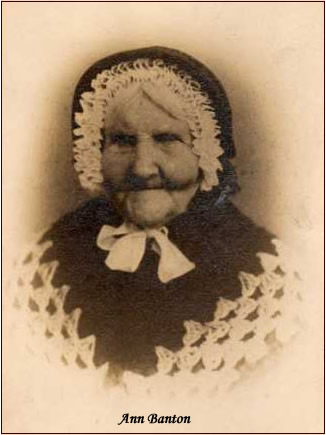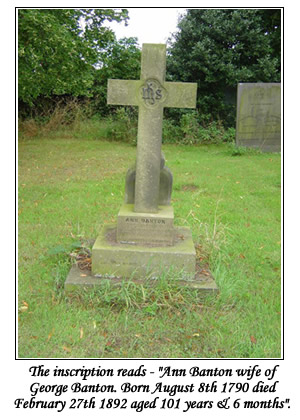I am often asked what started off my interest in family history. It was the photograph shown here, together with an article, which appears to be from a church magazine or almanac, which I found in my late mother’s effects. Since I had never come across this surname before, I set out to discover who Ann Banton was.

Ann Banton was my great x4 grandmother. She was born in Ticknall, Derbyshire on 8th August 1790. She was one of twelve children, six of whom lived to be eighty or ninety years of age. Ann surpassed them all by living well into her one hundred and second year. She died of gangrene on the 27th February 1892.For three years from the age of fifteen she lived in the service of the Hutchinson’s of Ticknall. In 1811 she became a dairymaid to Sir Henry Harpur-Crewe, but left in 1812 to marry her second cousin, George Banton.
From the article I found, it appears that Ann had a wonderful one hundredth birthday celebration. It states – “Noted as this village is for longevity, its record of great ages was crowned on Friday, the 8th August, by an event of the most interesting character, when a venerable widow – Ann Banton – on the Harpur-Crewe Estate celebrated her hundredth birthday. The occasion was deemed too important to be lightly passed over”.
To start the day the ‘venerable widow’ was taken in the vicar’s carriage to see her relatives and friends in different parts of the village, being cheered and congratulated all along the way.
On returning home she and her closest family sat down to a splendid meal, and at about half-past-four, forty of her family and one or two friends were, “regaled with a splendid meat tea and other delicacies”.
The article described how four generations of her family attended the party at which there was, “venison, roast beef and plum pudding provided by Sir Vauncey H. Crewe and the Hon. Lady Crewe”.
The Reverend T.J. Jones said a few appropriate words and presented the birthday girl with a magnificent bouquet, “kindly sent from London by Mr. H.H. Crewe”. At the same time the church bells rang out in honour of the event.

We are told that at the time of her one hundredth birthday, Ann Banton’s faculties were wonderfully preserved. She was able to see herself in a mirror without spectacles and could read with glasses of a low power.
She was also managing the household of her son-in-law, with whom she lived and whose children she had brought up. She was still able to walk about with ease and could visit friends and family nearby.
The author of the article reports, “She gave us quite a ‘startler’ when she informed us that in the preceding week she had herself dug up a sufficient quantity of potatoes for her son-in-law and grandson’s supper”.
The same article then goes on to describe the scene one year later, when Ann had just celebrated her one hundred and first birthday on a Saturday. It tells of how all her faculties were as sharp as ever. It then describes the scene on the following Monday at the parish church in Ticknall. There was a large gathering of people there to celebrate the marriage of Mrs. Banton’s granddaughter. Ann arrived on the arm of “her only living son, a ‘young’ man of but 78 years”.
The event was made even more interesting by the old lady stepping forward and giving away her granddaughter. The church, churchyard and church lane were thronged, and mother and son were not allowed to pass the vicarage gates without refreshment and congratulations from the vicar and his family. They were then driven home through a long line of villagers and friends. The report describes that, “Loud and merry peals from the church bells were rung both Saturday and Sunday”.
I only wish that I had been around at the birthday party to hear Ann reminisce about what was happening in England at the time of the Peninsular War and, “recount the events connected with the press-gangs, and the military ardour of the men of that day to go and fight ‘Old Boney’”, as the article had described.
Ann Banton sounds to have been a remarkable woman and I feel proud to say her blood runs in my veins.
Cath RJ
© Cath RJ 2008